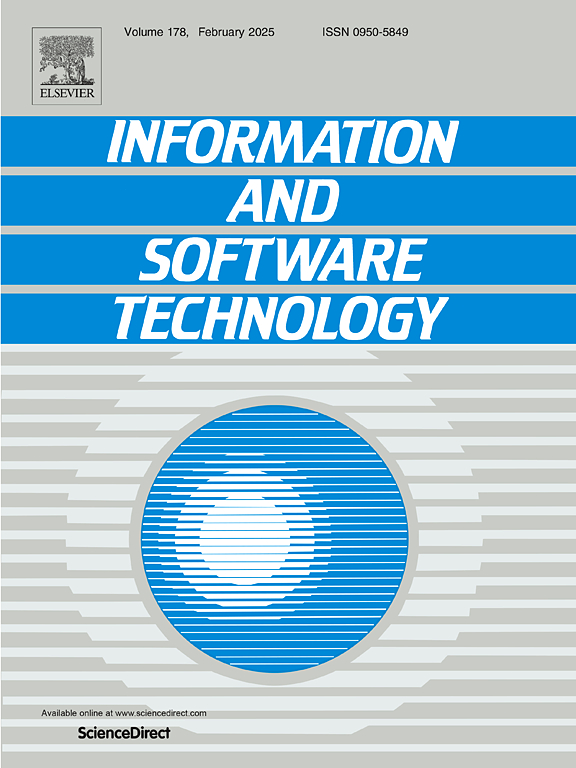Agile software development method cargo cult - Devising an analytical tool
IF 4.3
2区 计算机科学
Q2 COMPUTER SCIENCE, INFORMATION SYSTEMS
引用次数: 0
Abstract
Context
Despite the widespread adoption of agile software development methods (ASDMs) today, many organizations struggle with effective implementation. One reason for this is that some organizations claim to use an ASDM without fully understanding its core principles, or they adhere to old practices while professing to follow a contemporary software development method. This phenomenon is sometimes referred to by practitioners as “cargo cult” (CC) behavior. However, simply labeling something as CC lacks analytical depth.
Objective
This paper aims to conceptualize and validate an analytical tool for diagnosing CC and non-CC behavior in software development teams’ use of ASDMs.
Method
This study uses a longitudinal ethnographic approach to conceptualize and validate the analytical tool by analyzing four agile practices used by a global industrial manufacturing company.
Results
The analytical tool features eight stereotypes—three representing non-CC behaviors and five representing CC behaviors—designed to aid in the analysis of ASDM usage. The tool draws on Social Action Theory and Work Motivation Theory to capture and interpret the CC phenomenon in ASDM use. Using the stereotypes, 36 actions were categorized as CC behavior deviating from documented ASDM practices, and 23 actions as non-CC behavior because they aligned with the documented ASDM and reflected agile goals and values. The tool thus can help both researchers and practitioners gain a deeper understanding of ASDM use in organizations.
Conclusion
This study advances understanding of ASDM use by moving beyond the simplistic use of the term “cargo cult”. The developed tool enables structured identification and classification of CC behaviors. The stereotypes provide a way of classifying recurring software development actions against the intended ASDM, allowing the identification of specific types of CC behaviors. The analytical tool enables managers to gain deeper insights into the underlying reasons for deviations, thereby supporting more grounded and effective agile practices within organizations.
敏捷软件开发方法货物崇拜——设计一个分析工具
尽管敏捷软件开发方法(asdm)在今天得到了广泛的采用,但是许多组织都在为有效的实现而挣扎。其中一个原因是,一些组织声称在没有完全理解ASDM核心原则的情况下使用ASDM,或者他们坚持旧的实践,同时声称遵循现代的软件开发方法。这种现象有时被实践者称为“货物崇拜”(CC)行为。然而,简单地将某些东西标记为CC缺乏分析深度。目的:本文旨在概念化并验证一种分析工具,用于诊断软件开发团队使用asdm时的CC和非CC行为。方法本研究采用纵向民族志方法,通过分析一家全球工业制造公司使用的四种敏捷实践,对分析工具进行概念化和验证。结果该分析工具具有8个原型,其中3个代表非CC行为,5个代表CC行为,旨在帮助分析ASDM的使用情况。该工具利用社会行动理论和工作动机理论来捕捉和解释ASDM使用中的CC现象。使用原型,36个动作被归类为偏离文档化ASDM实践的CC行为,23个动作被归类为非CC行为,因为它们与文档化ASDM保持一致,并反映了敏捷的目标和价值观。因此,该工具可以帮助研究人员和实践者更深入地了解组织中ASDM的使用。本研究通过超越“货物崇拜”一词的简单使用,促进了对ASDM使用的理解。开发的工具支持对CC行为进行结构化识别和分类。原型提供了一种针对预期ASDM对重复的软件开发操作进行分类的方法,允许识别特定类型的CC行为。分析工具使管理人员能够更深入地了解偏差的潜在原因,从而在组织中支持更基础和更有效的敏捷实践。
本文章由计算机程序翻译,如有差异,请以英文原文为准。
求助全文
约1分钟内获得全文
求助全文
来源期刊

Information and Software Technology
工程技术-计算机:软件工程
CiteScore
9.10
自引率
7.70%
发文量
164
审稿时长
9.6 weeks
期刊介绍:
Information and Software Technology is the international archival journal focusing on research and experience that contributes to the improvement of software development practices. The journal''s scope includes methods and techniques to better engineer software and manage its development. Articles submitted for review should have a clear component of software engineering or address ways to improve the engineering and management of software development. Areas covered by the journal include:
• Software management, quality and metrics,
• Software processes,
• Software architecture, modelling, specification, design and programming
• Functional and non-functional software requirements
• Software testing and verification & validation
• Empirical studies of all aspects of engineering and managing software development
Short Communications is a new section dedicated to short papers addressing new ideas, controversial opinions, "Negative" results and much more. Read the Guide for authors for more information.
The journal encourages and welcomes submissions of systematic literature studies (reviews and maps) within the scope of the journal. Information and Software Technology is the premiere outlet for systematic literature studies in software engineering.
 求助内容:
求助内容: 应助结果提醒方式:
应助结果提醒方式:


